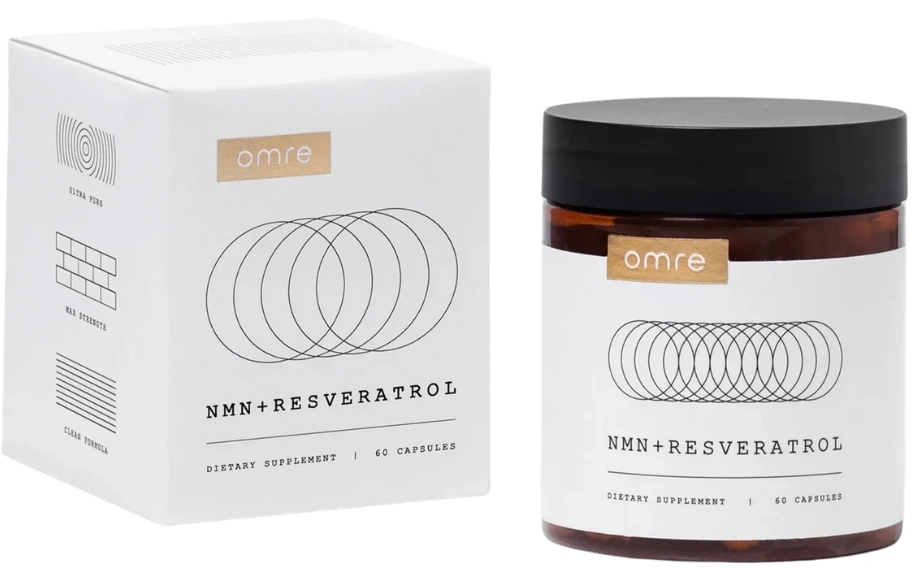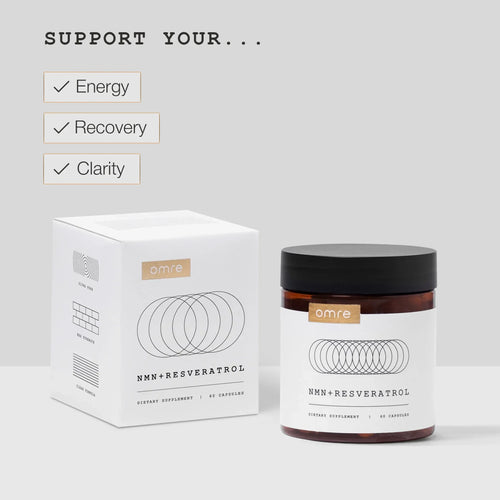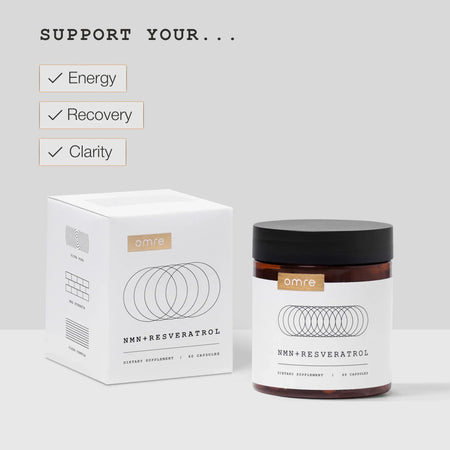Table of Contents
- TL;DR: Nicotinamide Riboside vs Niacin
- Key Differences Between Nicotinamide Riboside and Niacin
- What is Nicotinamide Riboside (NR)?
- What is Niacin?
- NAD+ Pathways Explained
- Health Benefits Compared
- Safety and Side Effects
- Dosage and Bioavailability
- Which One Should You Take?
- A Smarter Way to Support NAD+ Naturally
- Final Words
- FAQs
If you're comparing nicotinamide riboside vs niacin to support your energy, aging, or cholesterol levels, understanding how each form of Vitamin B3 works can help you choose the right one.
Both play a role in boosting NAD+ levels, but they take different routes in the body and offer unique benefits.
In this article, we’ll break down how they work, what they’re good for, and which one might suit your health goals best.
NMN + RESVERATROL
Cellular NAD+ booster with ultra-pure NMN and Resveratrol, at research-backed doses.*
TL;DR: Nicotinamide Riboside vs Niacin
Nicotinamide Riboside (NR) is ideal for boosting energy, metabolism, and healthy aging, while niacin is better known for lowering cholesterol and improving skin health. NR is more efficient at raising NAD+ but comes at a higher cost, while niacin is widely available and budget-friendly.
Key Differences Between Nicotinamide Riboside and Niacin
While both are forms of Vitamin B3 and help increase NAD+ levels, they differ in how they work, their benefits, and how well they’re tolerated.
What is Nicotinamide Riboside (NR)?
Nicotinamide riboside (NR) is a form of Vitamin B3 that helps raise NAD+ levels in the body, which is important for energy, metabolism, and healthy aging. It’s often used in supplements marketed for cellular health and longevity.
NR is a newer form of B3 that your body can quickly convert into NAD+, a molecule that plays a big role in how your cells make energy and repair themselves.
Research shows that taking NR supplements can increase NAD+ levels in the blood by up to 90% with regular use (1). It’s generally well-tolerated, with mild side effects like fatigue or nausea only showing up at high doses.
What makes NR different is its efficient pathway to NAD+. It skips some of the slower steps that other B3 forms need, which is why many people looking for an “anti-aging” boost or better energy metabolism turn to this version.
What is Niacin?
Niacin is one of the original forms of Vitamin B3, best known for supporting heart health and helping manage cholesterol levels (2). It comes in two forms: nicotinic acid and nicotinamide (also called niacinamide).
Nicotinic acid is often used at high doses to lower LDL (“bad”) cholesterol and raise HDL (“good”) cholesterol. However, it can cause a flushing effect—redness, warmth, and itching—that many people find uncomfortable.
Nicotinamide, on the other hand, avoids flushing and is used more for skin health and general B3 supplementation.
Both forms of niacin support NAD+ production in the body, though they’re less efficient at it compared to NR.
Still, niacin has decades of clinical use behind it, especially for cardiovascular benefits and skin support, making it a reliable choice for many people.
NAD+ Pathways Explained
NAD+ (nicotinamide adenine dinucleotide) is a coenzyme found in every cell. It helps your body convert food into energy, repair DNA, and manage how cells respond to stress and aging. Low NAD+ levels are linked to fatigue, poor metabolism, and age-related decline.
Niacin converts to NAD+ through a pathway called the Preiss–Handler pathway. This route is effective, but it includes multiple steps, including some slower ones, like conversion through intermediates that depend on certain enzymes.
For nicotinamide (a niacin form), the conversion happens through the salvage pathway, which can slow down with age.
Nicotinamide riboside follows the NRK (nicotinamide riboside kinase) pathway, which is shorter and more direct.
It skips the rate-limiting step found in niacinamide’s salvage pathway. That’s one reason NR may raise NAD+ more efficiently than niacin or nicotinamide.
In short, both forms can help replenish NAD+, but NR does it more efficiently by taking a shortcut in the metabolic process.
NMN + RESVERATROL
Cellular NAD+ booster with ultra-pure NMN and Resveratrol, at research-backed doses.*
Health Benefits Compared
 Both nicotinamide riboside and niacin offer unique health benefits, depending on what you're looking to improve, whether it's energy, aging, heart health, or skin.
Both nicotinamide riboside and niacin offer unique health benefits, depending on what you're looking to improve, whether it's energy, aging, heart health, or skin.
Benefits of Nicotinamide Riboside
Nicotinamide riboside (NR) is often used to support cellular energy and healthy aging. While it’s a newer form of Vitamin B3, early research shows promising effects, especially for people looking to raise NAD+ levels and support mitochondrial function.
Some of the potential benefits of NR include:
NAD+ Boosting: Several human studies show that NR can raise NAD+ levels by 40 to 90% with daily doses between 250–1000 mg (3).
Mitochondrial Support: NR may help improve how your cells produce energy, especially in older adults, by supporting mitochondrial health (4).
Sirtuin Activation: These are proteins linked to metabolism and longevity. NR has been shown to activate sirtuins like SIRT1 and SIRT3, which may play a role in healthy aging (5).
Early Signs of Metabolic and Cognitive Support: Preliminary studies suggest potential benefits for people with conditions like high blood pressure, insulin resistance, or early cognitive decline, but more research is still needed (6).
Benefits of Niacin and Nicotinamide
Niacin and nicotinamide (also called niacinamide) have a longer history of use and come with well-documented health benefits. These forms are especially helpful for cholesterol support, skin health, and more general vitamin B3 needs.
Here’s what the research shows:
Heart Health: Prescription-strength niacin is known to raise HDL (good cholesterol) and lower LDL (bad cholesterol) and triglycerides. The Mayo Clinic notes it’s sometimes used to help manage high cholesterol when statins aren’t enough (7).
Skin Health: Niacinamide is widely used for acne, rosacea, and signs of aging like wrinkles and discoloration. A large clinical trial (ONTRAC study) also found that 500 mg of nicotinamide twice daily helped reduce the risk of non-melanoma skin cancers in high-risk patients (8).
Kidney and Joint Support: Niacin has been studied for helping manage high phosphate levels in people with kidney disease, and nicotinamide may reduce joint pain in people with osteoarthritis when taken at higher doses (around 3 grams per day) (9).
Affordable and Widely Available: Compared to NR, niacin and niacinamide are much more budget-friendly and easier to find in both multivitamins and targeted supplements.
Safety and Side Effects
Both nicotinamide riboside and niacin are generally safe when used appropriately, but they come with different side effect profiles depending on the form and dosage.
Nicotinamide Riboside Side Effects
NR is usually well-tolerated, even at doses up to 1000–2000 mg per day (10). Most people don’t notice any issues, but a few may experience mild side effects:
Nausea
Fatigue
Bloating or stomach upset
Headache or dizziness
Skin discomfort in rare cases
There’s no flushing with NR, unlike niacin, and no serious side effects have been reported in human trials so far.
However, long-term safety data is still limited, so it’s wise to consult a healthcare provider before starting high doses.
Niacin and Nicotinamide Side Effects
Niacin, especially in the form of nicotinic acid, can cause flushing, a temporary but uncomfortable reaction where the skin turns red, feels warm, and sometimes itches. This tends to happen with higher doses (usually 50 mg or more) and fades with regular use.
Other potential side effects of niacin or nicotinamide include:
Upset stomach or nausea
Dizziness or fatigue
Liver stress at high doses (especially above 2–3 grams per day)
Mild blood sugar increase in some people
Niacinamide may inhibit certain enzymes (sirtuins) if taken in very large doses, which could work against some longevity goals
If you’re using these supplements for a specific condition or in high doses, it’s a good idea to work with a doctor to monitor liver function and overall safety.
Dosage and Bioavailability
Both nicotinamide riboside and niacin are effective at raising NAD+ levels, but they differ in how much you need to take and how your body processes each one.
Nicotinamide Riboside
Typical NR doses range from 250 mg to 1000 mg per day. Studies show that even 250 mg can raise NAD+ by about 40%, while 500 mg may boost it by up to 90% in the blood.
It's quickly absorbed and converted into NAD+, making it one of the more efficient B3 forms for cellular energy support.
However, some of it gets converted into nicotinamide in the process, which may reduce its long-term effectiveness at higher doses.
Niacin / Nicotinamide
Niacinamide (NAM) is usually taken at lower doses for general health (around 500 mg), though higher doses, up to 3 grams per day, are sometimes used for conditions like osteoarthritis or skin cancer prevention.
It's widely absorbed and affordable but relies on the slower salvage pathway to make NAD+, which may be less efficient with age.
Niacin (nicotinic acid) also raises NAD+ but is more known for its effect on cholesterol.
Which One Should You Take?
-v1750113285459.webp) Choosing between NR and niacin depends on your personal goals, budget, and how your body responds to each supplement.
Choosing between NR and niacin depends on your personal goals, budget, and how your body responds to each supplement.
Choose Nicotinamide Riboside If You:
Want to raise NAD+ levels efficiently for energy, metabolism, or longevity
Are focused on mitochondrial support and sirtuin activation
Prefer a supplement with fewer side effects and no flushing
Are comfortable with higher price points and newer research
Choose Niacin or Nicotinamide If You:
Are looking for proven support with cholesterol or skin health
Want a more budget-friendly, well-studied option
Prefer to avoid newer supplements with less long-term data
Don’t mind the potential for flushing (if using nicotinic acid) or want a non-flushing form like niacinamide
A Smarter Way to Support NAD+ Naturally
If you're looking for a simpler, well-rounded way to support NAD+ without choosing between NR or niacin, NMN might be the answer.
Nicotinamide Mononucleotide (NMN) is a direct precursor to NAD+, meaning your body can convert it without extra steps or bottlenecks. Unlike NR, NMN doesn’t need to be broken down before being used.
And when paired with Resveratrol, which activates sirtuins (enzymes tied to aging and metabolism), you get a double effect: higher NAD+ and better cellular response.
One supplement that does this well is Omre NMN + Resveratrol. Each serving includes 500 mg of ultra-pure NMN and 500 mg of Resveratrol, plus 5 mg of BioPerine® for better absorption.
That’s a research-backed dose without any fillers or unnecessary extras.
What sets it apart is the quality. The NMN is 99% pure, and the Resveratrol is 98% micronized for better absorption.
Many brands cut corners with low-purity ingredients, but Omre focuses on clean, high-impact formulas. It’s all-natural, third-party tested, and manufactured in a GMP-certified, FDA-registered facility in the USA.
If you're aiming to improve energy, support healthy aging, or simply feel better day-to-day, this combo offers a strong and balanced way to keep your NAD+ levels thriving.
Final Words
Nicotinamide riboside and niacin are both forms of Vitamin B3, but they serve different purposes. NR is best known for raising NAD+ levels efficiently and supporting cellular energy, while niacin and niacinamide offer proven benefits for cholesterol, skin health, and general B3 needs.
Your choice depends on your health goals, budget, and how your body responds.
If you're looking for a well-rounded, research-backed way to support NAD+ naturally, consider adding a high-quality NMN supplement to your routine.  Omre NMN + Resveratrol combines ultra-pure ingredients with proper dosing for real impact.
Omre NMN + Resveratrol combines ultra-pure ingredients with proper dosing for real impact.
Check availability to see if it's the right fit for you.
FAQs
Is nicotinamide the same as niacinamide?
Yes, nicotinamide and niacinamide are two names for the same compound. “Niacinamide” is commonly used in skincare, while “nicotinamide” is more often used in supplements and research.
Can I take NR and NAM together?
You can, but it might not be necessary. NR often converts to NAM in the body anyway, so taking both may not offer extra benefit. It's best to talk with a healthcare provider before combining them.
Does NR cause flushing?
No, nicotinamide riboside does not cause flushing. Flushing is mostly linked to high doses of nicotinic acid, not NR or niacinamide.
Which B3 form is best for aging skin?
Niacinamide (nicotinamide) has the strongest clinical evidence for improving skin texture, reducing wrinkles, and managing acne or redness. It’s widely used in both supplements and topical products.
Is niacin bad for the liver?
Niacin is safe at recommended doses, but high doses (especially over 2–3 grams per day) can put stress on the liver. Always follow dosing guidelines and consult a doctor if you're taking it long-term.





